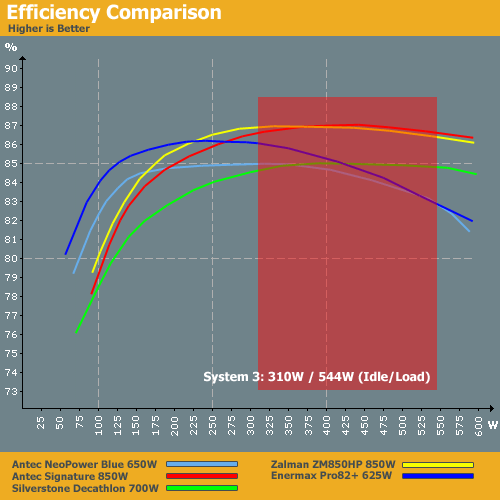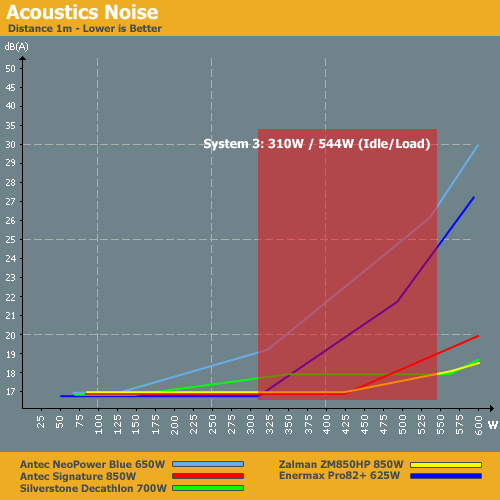Debunking Power Supply Myths
by Christoph Katzer on September 22, 2008 3:00 AM EST- Posted in
- Cases/Cooling/PSUs
PSUs for High-End Systems
Even though our high-end system consumes more power, we used the same graph layout. That means the resulting graphs stop at 600W, despite the high-end PSUs all being capable of providing more power than that. Our high-end system sports an SLI setup using two NVIDIA 8800 ultra cards; 3-way SLI would be a bit more demanding, but we don't feel it's a good indication of what people are actually running. The third card would also only add another 50W to 90W of power consumption to our system, since the third card is rarely taxed as much as the first GPU.
- Antec NeoPower Blue (650W) actively cooled
- Antec Signature (850W) actively cooled
- Silverstone Decathlon (700W) actively cooled
- Zalman ZM850HP (850W) actively cooled
- Enermax Pro82+ (625W) actively cooled

We've included the Enermax Pro82+ 625W from the midrange selection as well. Again, efficiency is not the major issue when it comes to choosing between these products. The two lowest rated power supplies -- Antec NeoPower 650W and Enermax Pro82+ 625W -- are less efficient over the tested range, but that's expected. The results all of her around 85% to 87% mark, and one or 2% difference really isn't going to matter much. Still, the Zalman and Antec 850W units place at the top of this chart.

Again, the two power supplies with the lowest output rating perform worse in this test, generating much more noise than the competition. The higher rated units don't have to work as hard, since they are running at a medium load. Those three PSUs remain very quiet along with providing better efficiency, making them the better for a high-end setup. The Zalman and Antec Signature 850W units would be our choice, if only for the extra headroom. Either PSU would have no difficulty with a 3-way GPU setup, provided you have sufficient PEG connections available. That brings up the next topic of discussion.










98 Comments
View All Comments
JarredWalton - Monday, September 22, 2008 - link
If you look at all the included components, it should be pretty clear that the latest parts won't be drastically different from the tested components. Sure, 4870 might use 30W more (or 30W less) than the 3870, and the P45 might use +/-10W relative to the P35. Does that really change anything with the information the article conveys? I don't think so. Midrange PCs are still going to use 150-250W for the most part, whether with last year's components or with the latest stuff. If you want to look at the top-end, then GTX 280 will use more power than the listed GPUs, but even then you're not going to break 600W without overclocking.Martimus - Tuesday, September 23, 2008 - link
Thanks. I have since calculated out what is needed for the processor and chipset (for a E8400 and P45 MB) and it came to about 8A. I went on the AMD website to find what the current draw was from the 4870. It doesn't say, but does recommend a 500W PSU. I am a little concerned though, because the EA500 isn't on their approved PSU list from Antec, and I have had issues with their power supplies before, plus they only have 17A available on each rail. that should be fine, but I would like to make sure I am not loading the 12V rail too heavily as well. If those components don't work (those are my plan for the moment), then I can always adjust, but I would like to have that peace of mind before I make the purchases. (the computer is a present, and I bought the Sonata III to save money because I heard good things about the Earthwatts brand, but now I am starting to get worried about this particular model.)Matt Campbell - Monday, September 22, 2008 - link
I would also point out that in addition to all of the data Christoph has pulled together, we have some power consumption numbers on overclocked systems with GTX 280s as well, which seems to be one area people are asking for.4.0 GHz QX9770 with SLI GTX 280s: 579W Max
4.0 GHz QX9650 with Triple 8800 Ultras: 671W Max
JarredWalton - Monday, September 22, 2008 - link
Those figures are power at the outlet, though, right? And they're not tested in the same fashion as what Christoph did. Still, if you max out at 671W at the outlet, even with 88% efficiency you're only using 590W - nowhere near 1200W, which is what NVIDIA certifies for 3-way SLI. Quality over quantity, naturally, but there really aren't many terrible 1000W PSUs out there (which is why they all cost over $200).Torched - Monday, September 22, 2008 - link
For all the hullabaloo about the 12v Rail why nor just recommend a PS that has a single rail. More and more manufacturers are going in that direction anyways since it eliminates the whole power trapping issue.gramboh - Monday, September 22, 2008 - link
Good article. The underlying point is that you do not need 1000-1500W PSUs to run your system like I see many people claiming you do for SLI setups. I see lots of people with 700-800W PSUs with one graphics card. Insane.I've been running a Corsair HX520 (520W) for a year and a half now. My current config is:
Asus P5B-Deluxe (P965) mobo
Q6700 G0 @ 3.3GHz (1.42v actual voltage reported by Speedfan)
4x1GB PC2-6400 DDR2 memory
EVGA GTX280 video card overclocked (675-1350-2422)
3 hard drives (7200.11 1TB + 2x 7200.10 500GB)
1 optical (18x Samsung DVDRW SATA)
3 case fans ~1500rpm + CPU fan 1200rpm
SB X-Fi XtremeGamer audio
Zero issues and I'm sure I have headroom to spare. Some people on forums told me I should upgrade my PSU to at least a 650W Corsair or 750-800 of other brands to run the 6700/GTX280, just goes to show people have fallen for the marketing hype of PSUs.
cesthree - Monday, September 22, 2008 - link
I have had a few different systems in the last 6 months. Using the Zalman MFC-2 I can see the wattage being used in real-time. How accurate it is, I do not know, but it gets me in the ballpark.All systems have had the same 4 WD1600YS HDD, Lite-On DVD burner, 700W OCZ GameXStream PSU, and OCZ DDR3 1333Mhz 2x1 GB RAM. I also run 4 x 120mm fans including the one mounted to my TRUE-120.
Set-ups:
1. EVGA 790i Ultra (JUNK) w/ Q6600 @ 3.2Ghz 1.35VCORE, 1400Mhz FSB, 8800GTS 320MB SLI
Idle Load: 225W, Prime Load: 275W, 3DMARK06: 325W.
Never saw higher than 400-425W during highest loads.
2. DFI X48-T3RS (PWNING 790i ULTRA) w/ Q6600 @ 3.0Ghz 1.32VCORE, 1333Mhz FSB, EVGA 9800GTX
Idle Load: 200W, Prime Load: 250W, 3DMARK06: 290W.
Never saw higher than 350-375W during highest loads.
3. DFI X48-T3RS w/ E8400 @ 3.0Ghz 1.245VCORE, 1333MHZ FSB, EVGA 9800GTX
Idle Load: 175W, Prime Load: 200W, 3DMARK06: 250W.
Never saw higher than 300-325W during highest loads.
BTW, all Watts are averages. Prime Load is averages between blend testing and small FFT's.
I really like the meter on the MFC-2. If it is at all accurate, then it supports the logic that it isn't always necessary to have a 2000KW PSU.
I could see needing a higher wattage, QUALITY PSU, for CF or SLI + the latest GPU'S, non-extreme CPU, with everything OC'd 25-50%, and maybe a single loop WC as well.
Just my 2 cents.
Spacecomber - Monday, September 22, 2008 - link
I was wondering if it might have been helpful to add some comments on the importance (or not) or having 8-pin 12-volt motherboard connectors, instead of the more standard 4-pin motherboard connector. I don't think that this motherboard connector, which I think largely powers the CPU, was given much attention relative to the discussion of the additional 4-pin connector for the main motherboard connector (20 + 4) and the PCI-E power connectors.Overall, this was a very good article. I like how it places technical details about power supplies into a context of everyday use.
CSMR - Monday, September 22, 2008 - link
The power consumption data on page 1 is completely overblown.The tables claim to represent actual power consumption of processors and chipsets but the figures are completely exaggerated.
There are even people who run whole systems on one or two of the chipsets listed on less power than the power the article claims for just the chipset.
Here are actual CPU measurements from behardware and xbitlabs:
http://www.xbitlabs.com/articles/cpu/display/intel...">http://www.xbitlabs.com/articles/cpu/display/intel...
http://www.xbitlabs.com/articles/cpu/display/intel...">http://www.xbitlabs.com/articles/cpu/display/intel...
I haven't seen measurements of chipset power but here is a list of TDPs:
http://www.silentpcreview.com/forums/viewtopic.php...">http://www.silentpcreview.com/forums/viewtopic.php...
Must fix this soon as Anand needs to keep its reputation for good information.
Zoatebix - Monday, September 22, 2008 - link
Seriously. This guy didn't go too far our of his way to make a 30-40 watt system: http://www.silentpcreview.com/forums/viewtopic.php...">http://www.silentpcreview.com/forums/vi...tdays=0&...